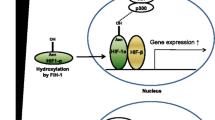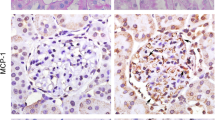Abstract
Background
Fibrin deposition within glomeruli is commonly seen in kidney biopsy specimens, suggesting enhanced coagulant activity. Tissue factor (TF) is a coagulation factor which is also related to various biological effects, and TF is upregulated by hypoxia in cancer cells. Recently, hypoxic podocyte injury has been proposed, therefore, we investigated TF expression in hypoxia.
Methods
Conditionally immortalized human podocytes were differentiated and treated under hypoxic or normoxic conditions. mRNA expressions of TF and tissue factor pathway inhibitor (TFPI) were analyzed by quantitative RT-PCR. Protein levels of TF and TFPI were tested by enzyme-linked immunosorbent assay. We employed small interfering RNA (siRNA) to temporary knockdown early growth response protein 1 (Egr-1), hypoxia-inducible factor-1α (HIF-1α) and TF. The expression of CD2-associated protein (CD2AP) mRNA and phalloidin staining was examined to assess podocyte injury.
Results
Hypoxia increased mRNA expression of TF (6 h: 2.3 ± 0.05 fold, p < 0.001, 24 h: 5.6 ± 2.4 fold, p < 0.05) and suppressed TFPI (6 h: 0.54 ± 0.04 fold, p < 0.05, 24 h: 0.24 ± 0.06 fold, p < 0.001) compared with normoxia. Similarly, protein levels of TF were increased and TFPI were decreased. Egr-1 siRNA did not change TF mRNA expression. Pyrrolidine dithiocarbamate (PDTC), a nuclear factor kappa B (NF-κB) inhibitor, significantly reduced hypoxia induced TF expression, and HIF-1α knockdown further increased TF. Hypoxia resulted in decreased CD2AP and actin reorganization in podocytes, and these changes were attenuated by TF siRNA.
Conclusion
Hypoxia increased the expression of TF in human podocytes NF-κB dependently. TF may have a critical role in the hypoxic podocyte injury.








Similar content being viewed by others
References
Apostolopoulos J, Moussa L, Tipping PG. The cytoplasmic domain of tissue factor restricts physiological albuminuria and pathological proteinuria associated with glomerulonephritis in mice. Nephron Exp nephrol. 2010;116(4):e72–83.
Luyendyk JP, Sullivan BP, Guo GL, Wang R. Tissue factor-deficiency and protease activated receptor-1-deficiency reduce inflammation elicited by diet-induced steatohepatitis in mice. Am J Pathol. 2010;176(1):177–86.
Chu AJ. Tissue factor, blood coagulation, and beyond: an overview. Int J Inflam. 2011;2011:367284.
Yamabe H, Yoshikawa S, Ohsawa H, Inuma H, Miyata M, Sasaki T, et al. Tissue factor production by cultured rat glomerular epithelial cells. Nephrol Dial Transpl. 1993;8(6):519–23.
Yamabe H, Osawa H, Inuma H, Kaizuka M, Tamura N, Tsunoda S, et al. Tissue factor pathway inhibitor production by human mesangial cells in culture. Thromb Haemost. 1996;76(2):215–9.
Sugawara T, Yamabe H, Osawa H, Kaizuka M, Shirato K, Nakamura M, et al. Tissue factor pathway inhibitor production by human proximal tubular epithelial cells in culture. Thromb Res. 2003;110(2–3):141–7.
Yamabe H, Shimada M, Nakamura N, Murakami R, Shimaya Y, Fujita T, et al. Tissue factor pathway inhibitor (TFPI) production by human podocyte in culture. Thromb Res. 2010;126(1):e57.
Drake TA, Morrissey JH, Edgington TS. Selective cellular expression of tissue factor in human tissues. Implications for disorders of hemostasis and thrombosis. Am J Pathol. 1989;134(5):1087–97.
Mimura I, Nangaku M. The suffocating kidney: tubulointerstitial hypoxia in end-stage renal disease. Nat Rev Nephrol. 2010;6(11):667–78.
Neusser MA, Lindenmeyer MT, Moll AG, Segerer S, Edenhofer I, Sen K, et al. Human nephrosclerosis triggers a hypoxia-related glomerulopathy. Am J Pathol. 2010;176(2):594–607.
Ding M, Cui S, Li C, Jothy S, Haase V, Steer BM, et al. Loss of the tumor suppressor Vhlh leads to upregulation of Cxcr4 and rapidly progressive glomerulonephritis in mice. Nat Med. 2006;12(9):1081–7.
Wagner MC, Rhodes G, Wang E, Pruthi V, Arif E, Saleem MA, et al. Ischemic injury to kidney induces glomerular podocyte effacement and dissociation of slit diaphragm proteins Neph1 and ZO-1. J Biol Chem. 2008;283(51):35579–89.
Racusen LC, Prozialeck DH, Solez K. Glomerular epithelial cell changes after ischemia or dehydration. Possible role of angiotensin II. Am J Pathol. 1984;114(1):157–63.
Lu H, Kapur G, Mattoo TK, Lyman WD. Hypoxia decreases podocyte expression of slit diaphragm proteins. Int J Nephrol Renovac dis. 2012;5:101–7.
Rong Y, Hu F, Huang R, Mackman N, Horowitz JM, Jensen RL, et al. Early growth response gene-1 regulates hypoxia-induced expression of tissue factor in glioblastoma multiforme through hypoxia-inducible factor-1-independent mechanisms. Cancer Res. 2006;66(14):7067–74.
Eisenreich A, Zakrzewicz A, Huber K, Thierbach H, Pepke W, Goldin-Lang P, et al. Regulation of pro-angiogenic tissue factor expression in hypoxia-induced human lung cancer cells. Oncol Rep. 2013;30(1):462–70.
Sun L, Lin S, Zhao R, Yu B, Yuan S, Zhang L. The saponin monomer of dwarf lilyturf tuber, DT-13, reduces human breast cancer cell adhesion and migration during hypoxia via regulation of tissue factor. Biol Pharm Bull. 2010;33(7):1192–8.
Lowry OH, Rosebrough NJ, Farr AL, Randall RJ. Protein measurement with the Folin phenol reagent. J B iol Chem. 1951;193(1):265–75.
Chu AJ. Tissue factor mediates inflammation. Arch Biochem Biophys. 2005;440(2):123–32.
Muller M, Albrecht S, Golfert F, Hofer A, Funk RH, Magdolen V, et al. Localization of tissue factor in actin-filament-rich membrane areas of epithelial cells. Exp Cell Res. 1999;248(1):136–47.
Ott I, Fischer EG, Miyagi Y, Mueller BM, Ruf W. A role for tissue factor in cell adhesion and migration mediated by interaction with actin-binding protein 280. J Cell Biol. 1998;140(5):1241–53.
Dorfleutner A, Hintermann E, Tarui T, Takada Y, Ruf W. Cross-talk of integrin alpha3beta1 and tissue factor in cell migration. Mol Biol Cell. 2004;15(10):4416–25.
Turin TC, James M, Ravani P, Tonelli M, Manns BJ, Quinn R, et al. Proteinuria and rate of change in kidney function in a community-based population. J Am Soc Nephrol. 2013;24(10):1661–7.
Hemmelgarn BR, Manns BJ, Lloyd A, James MT, Klarenbach S, Quinn RR, et al. Relation between kidney function, proteinuria, and adverse outcomes. JAMA. 2010;303(5):423–9.
Author information
Authors and Affiliations
Corresponding author
Ethics declarations
Conflict of interest
The authors have declared that no conflict of interest exists.
About this article
Cite this article
Narita, I., Shimada, M., Yamabe, H. et al. NF-κB-dependent increase in tissue factor expression is responsible for hypoxic podocyte injury. Clin Exp Nephrol 20, 679–688 (2016). https://doi.org/10.1007/s10157-015-1214-z
Received:
Accepted:
Published:
Issue Date:
DOI: https://doi.org/10.1007/s10157-015-1214-z




